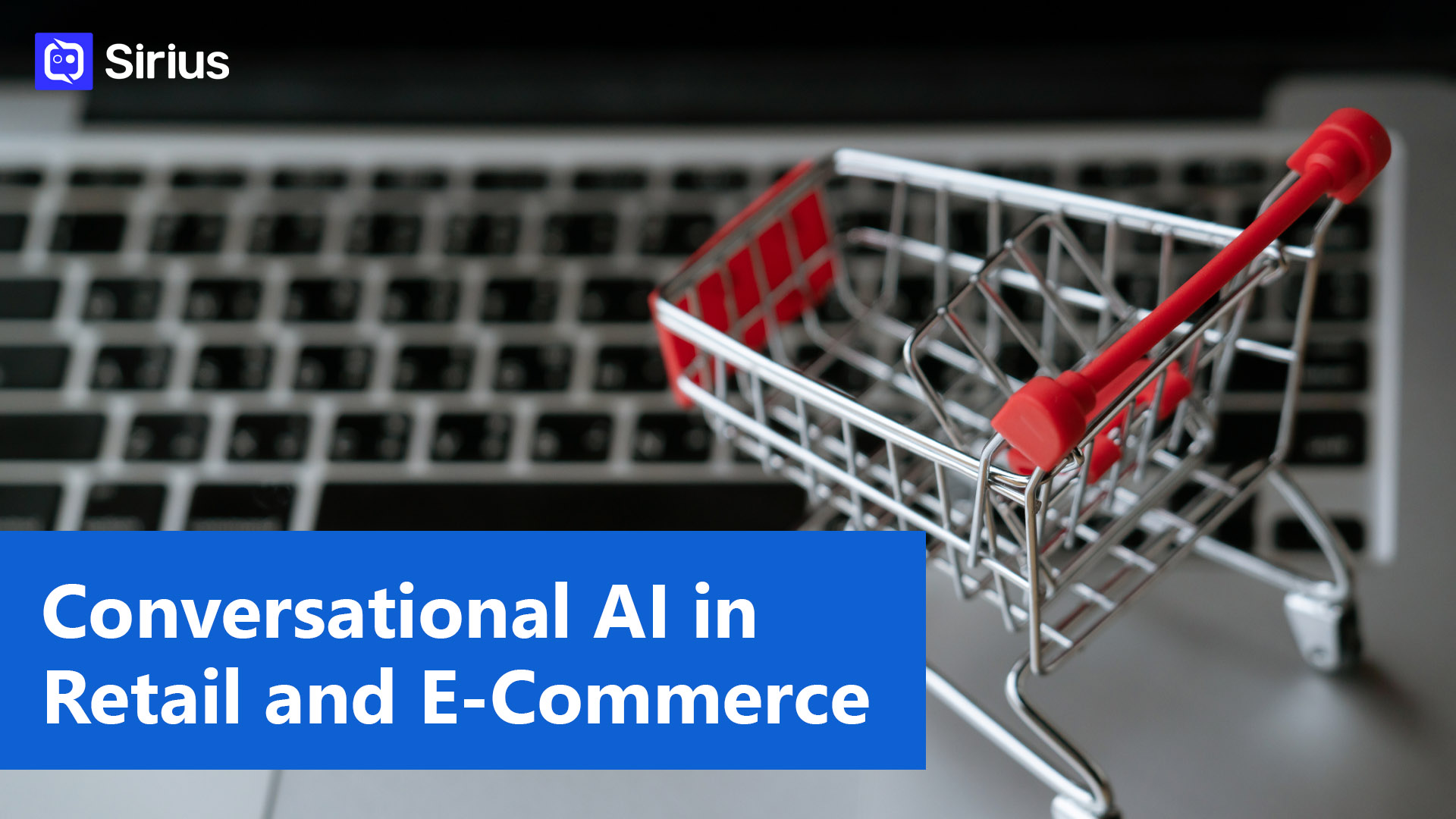Table of Contents
Deliver a personalized experience that resonates with your customers regardless of whether they are at home, in-store or waiting in line for lunch.
Conversational AI in Retail- Online shopping has evolved significantly over the years – first with the Internet, then mobile and now with the rise of conversational ai technology in retail and e-commerce. According to Martech, artificial intelligence chatbot will account for $112 billion in retail sales by 2023. It is estimated that 47% of consumers would be open to making a purchase from a conversational chatbot.
Customers’ expectations of how they should be able to interact with retailers have changed significantly over the last few years. Speed and convenience are driving the consumer agenda today, leaving the old standbys of price and brand loyalty out of the picture.
AI powered chatbots in retail and e-commerce have been a game-changer. After messaging apps, mobile friendly online shopping sites, artificial intelligence (including Machine Learning (ML), Natural Language Processing (NLP) and Natural Language Understanding (NLU)) is the next big thing. They have reduced friction and increased efficiency by bringing a store to the customers right in the comfort of their homes. Customers feel at ease when shopping at an e-store enabling brands take a leap to conversational commerce with the help of AI powered chatbots.
What is conversational AI?
Conversational Commerce brings together online messaging like live chat and conversational AI together to deliver a refined shopping experience to customers 24/7. Customers are offered a personalized shopping experience like never before since the dawn of online shopping.
Additionally, with excellent features like proactive reach, business can now intervene at critical moments like when a customer is hesitating at the time of online payment, checkout or when a customer goes back and forth between two products. Conversational commerce can also spark customer engagement and interest in the online shopping experience.
Key applications of chatbots in retail and e-commerce over apps or websites

1. Lead Generation
AI powered chatbot can help e-commerce companies engage with their customers by asking them questions, conducting surveys and even playing quizzes. This particularly will help e-commerce brands collect customers’ personal information and nurture them with relevant information. The process of generating leads and at the same time engaging with the visitor is a great opportunity for e-commerce businesses to build a positive relationship with their customers. Based on the information provided by customers, the virtual assistant can segment users based on demographics, interests and psycho-graphics. This will help e-commerce players reach the right customer with the right messaging.
2. Customer Engagement
AI-powered chatbots are equipped with machine learning (NLP), can hold human-like conversations with consumers and become more intelligent with every interaction. Given their automated nature, these tools are available 24×7, helping retail businesses address customer queries about products and services round the clock and eliminating, or greatly minimising wait-times. Customers can save upto 10 minutes of their time when interacting with a bot. With such factors in play, more retailers are realising the benefits of implementing bots as the first point of contact for their customers.
3. 24/7 Customer Service
Consumers today want to engage with your brand 24/7, have low attention spans, prefer to shop mobile first, and tend to rely on peer recommendations and online research before shopping any product. An AI-enabled chatbot is a 24/7 self-service tool, enabling consumers to connect with retailers to solve their product or service-related issues anytime anywhere, without having to wait for the customer care representative to respond. A study conducted by Aspect Software has shown that 73% of customers choose self-service features – motivating retailers to implement conversational AI solutions.
4. Customer Support
With conversational AI, businesses can provide delightful post-purchase experiences and save up to 90% of customer care costs using AI-driven chats. It can seamlessly respond to user queries such as order tracking, FAQs, payment issues, etc. and automatically route complex issues to support agents, powering the right mix of technology and human skills.
5. Product Notifications
Instead of sending promotional emails and nurturing customers through pre-defined flows, brands can use chatbots to promote products in real-time in a way that is more casual and conversational. Retailers, this way, can collect more information than a support system via a chatbot chatting with customers. Thus, marketing a product without a huge support team disappears.
6. Order Processing
Customers can now easily order products by simply chatting with a bot and entering personal details like name, telephone number, billing address, and payment method. Customers can then complete the checkout process directly within the app or channel of their choice or be redirected to a dedicated checkout page. The best example is the Starbucks app. Starbucks lets customers order their coffee or food through the chatbot in their app. Customers can just write what they would like to drink and the AI will recognize their intent and order for them on a single go with single tap payment.
7. Order Tracking
A customer can track their orders and shipped orders by reducing the number of steps needed to get this information. They can chat with a bot and learn the status of a purchase in a matter of seconds or use the bot to locate the nearest store by entering their zip code or address. 56% of millennials have switch from one company to another because of underwhelming customer service. Chatbots deployed can help employees quickly find the information they need, enabling a positive online experience.
8. In-store Assistance
Bots can be deployed to drive traffic to stores, such as through push notifications and coupons, and drive more sales when in store through self-service customer support, item location assistance, and right-time, right-fit offers at the point of sale. Walmart is saving huge amounts of time – and more than $1.4 billion a year – by using smart systems that tell staff when fridges aren’t working or have been left open. The system doesn’t just sound an alarm but prioritizes work, automates work orders in the most efficient way and, crucially, cuts down on time-wasting false-positive reports of malfunctions.
9. Holiday Promotions
Retail bots can help customers find the items they are looking for more easily, compare prices, and make the best decision. They can also be used to deliver highly targeted seasonal offers and to educate customers on current and upcoming holiday promotions. According to KANTAR RETAIL’S RETAILING 2020 vision, in 2020 brands will be less standard and more tailored to the specific customer. Touch points will be more complex and require proficient integration. Leading retailers will be those that are the best at understanding their shoppers’ needs, along with communicating a secure and self-confident image to their consumers.
Different channels of implementation for retail and e-commerce industry
Messaging Apps

Conversational AI in retail and e-commerce uses different messaging apps like Facebook Messenger, WhatsApp, Slack, KiK, WeChat and more to make conversations with customers easier without having to navigate to a different website or a phone app. With simple UI and faster access, these apps are growing in popularity and are continuing to provide potential value to retailers that chose to adopt them.
Chatbots

Artificial Intelligence chatbot allows customers to cater to their needs with the speed and agility they expect along with convenience, security and flexibility. The customers also get ample time before buying any product.
Voice Assistants

Alexa, Google Assistant and Siri have created a new definition of “comfortable” customer experience that has taken conversational commerce to a whole new level. Voice assistants make the conversation course with the customers more fluid by adding voice commands via text or speech. Customers having a seamless experience with voice assistants are likely to use it more, thereby increasing revenues.
By 2023, over 70% of all chatbots accessed will be retail based. Furthermore, chatbot ecommerce transactions will reach $112 billion annually – Juniper.
Conversational AI in retail and e-commerce has been adopted by some of the big brands in the world. Walmart and 1-800-Flowers are few of these big brands who have already adopted the conversational AI and are doing better with improved consumer shopping communications.
Benefits of conversational AI in retail and e-commerce

Conversational chatbot are data-driven, scalable, real-time and personalized. The idea behind conversational commerce is that it targets a part of the customer journey on the e-commerce store that is beneficial to that particular business. From sending a thank you email to the customer for shopping on their e-store to noting down customer feedback, it encompasses everything.
To customers, conversational AI offers:
- Fast and quick service
- Real store shopping experience
- One-to-one attention
- Easy decision-making support
- Seamless payment method
For retailers, conversational commerce is a sort of renaissance for their business and a door full of opportunities. Domino’s, H&M, Sephora and many more have already employed chatbots for delivering personalized experiences to their customers in the market.
[hbupro_banner id=”21839″]
3 ways conversational AI can increase customer engagement
1. Support Omni-channel Conversation
A website is a one-stop shop for customers. Multiple channels like Facebook Messenger, WhatsApp and other messaging platforms help to extend your reach. The channels are like virtual salespeople who meet customers where they already are marking the beginning of conversational e-commerce journey.
2. NLP Built Bots
Bots built with NLP can understand the intent of the customer queries, making the conversation with chatbots more human and personal. Moreover, AI-powered bots provide agents with information they need to help create a personalized experience for the customers.
3. Multi-lingual Bots
Consumers prefer to engage with bots that can communicate in their preferred language. Bots with multi-lingual capability can switch languages based on user’s accent. Chatbots can be integrated to multiple channels like Telegram, FB messenger, Slack and more enabling texting with customers in real-time. With the help of Google Home and Alexa, customer queries can also be answered through voice commands.
Juniper Research found that bots will help businesses save $8 billion annually by 2022. Today, that number is only $20 million.
Final impact and key takeaways
Conversational commerce is not a new development, but as customers get comfortable with online messaging and digital living, it is emerging as an excellent gateway for delivering loyal customers with personalised shopping experience.
Businesses with conversational commerce have seen considerable improvements in conversion rates, an increase in sales and decrease in customer call volumes. Artificial intelligence in chatbot platform help create intelligent bots that create faster, personalized interactions with customers and an overall increase the productivity for brands.
[mailerlite_form form_id=1]

















